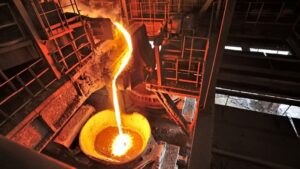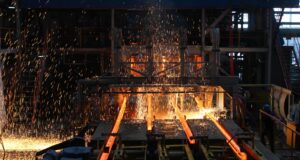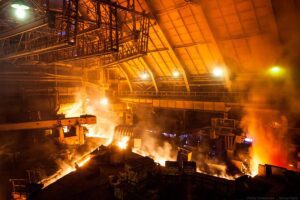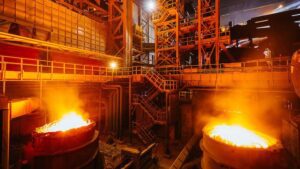
Metinvest Mining and Metallurgical Group through PrJSC Dniprovsky Coke and Chemical Plant (DKHZ, Kamianske, Dnipropetrovsk region), part of the group, will acquire an integral property complex of Dniprovsky Integrated Iron & Steel Works (DMK, Kamianske, Dnipropetrovsk region) for UAH 9.17 billion with a starting price of UAH 8.395 billion.
According to the information on the ProZorro.Sales platform, bids were accepted until July 25 inclusive, the auction was scheduled for July 26, but since one bid was submitted for the competition, the winner was determined without bidding.
Earlier, Interfax-Ukraine was informed that Metinvest would acquire DMK through its company, DKHZ.
DMK was undergoing reorganization as part of the bankruptcy proceedings of the enterprise.

Ukrainian metallurgical enterprises increased the production of general rolled products, according to recent data, by 6.6% in January-June this year compared to the same period last year, to 9.625 million tonnes.
According to the report of the Ukrmetalurgprom association, in the first five months of the year steel production grew by 7.5%, to 10.859 million tonnes, while cast iron output increased 8.1%, to 10.79 million tonnes.
In June, 1.602 million tonnes of rolled metal, 1.872 million tonnes of steel, and 1.887 million tonnes of cast iron were produced.
As reported, in 2020, Ukrainian metallurgical enterprises increased the production of general rolled products by 0.7% compared to the previous year, to 18.344 million tonnes, reduced steel output by 1.4%, to 20.549 million tonnes and increased cast iron production by 1.5%, to 20.358 million tonnes.

Metinvest, an international vertically integrated mining and metallurgical group of companies, will act as the general partner of the international forum “Decarbonization of the Steel Industry: a Challenge for Ukraine,” which will be held in Kyiv on July 14, 2021.
According to the company’s press release, an event on the topic that has been discussed by the entire international community in recent years will be held in Ukraine for the first time.
As noted, for many years of operation, Metinvest has been striving to reduce the negative impact of production on the environment. Over the past 10 years, the group has allocated more than $ 3.4 billion for environmental initiatives and is committed to further reducing its carbon footprint to combat climate change.
Meanwhile, achieving carbon neutrality will be a big challenge for Ukrainian companies, as it involves a complete change in production processes and supply chains. In addition, the necessary technologies that will make the country’s economy carbon-free are only at the research stage. To develop a detailed roadmap for the transition to a “green” industry requires interaction between manufacturers, engineering companies, consumers, suppliers and the government.
Yuriy Ryzhenkov, the director general of Metinvest, stressed that the industry is facing a serious task that will affect the life of the entire country.
“Decarbonization can completely change both production and technologies. The sooner business and the state develop a unified approach to achieving carbon neutrality, the easier this process will be for the Ukrainian economy,” the top manager stated.
The forum is organized by GMK Center, an information-analytical and consulting company working in the field of metallurgy and industry. At the forum it is planned to discuss issues related to decarbonization of steel production, existing and promising technologies, plans of companies to reduce CO2 emissions and interaction with the state in this direction. The event will be attended by the representatives of mining and metallurgical companies, international engineering, consulting and R&D companies, as well as government officials, business associations and industry experts.

The Ukrainian industrial company Interpipe in January-May this year increased steel production by 10.6% compared to the same period last year, to 368,200 tonnes.
According to the company’s monthly report, for the five months of 2021, pipe production increased by 6.4%, to 206,700 tonnes, the output of railway products decreased by 24.1%, to 68,000 tonnes.
In May, steel smelting amounted to 86,000 tonnes (in April – 89,200 tonnes), pipe production – 51,600 tonnes (48,300 tonnes), railway products – 13,000 tonnes (14,700 tonnes).
It is also reported that pipes in January-May of this year were sold in Europe (29%), the MENA region (25%), Ukraine (17%), the CIS (12%), the American continent (14%) and other regions (3%). In May, pipes were sold in Europe (24%), Ukraine (14%), the MENA region (30%), the CIS (11%), the American continent (17%) and other regions (4%).
Railway products for the five months of 2021 were sold in the CIS (48%), Europe (32%), Ukraine (8%), the MENA region (3%), the American continent (7%) and other regions (3%). In May – in the CIS (48%), Europe (29%), Ukraine (7%), the MENA region (2%), the American continent (4%) and in other regions (10%).
According to Interpipe’s commentary, in May 2021, the company’s trading activity continued to recover in all key products and markets in connection with the lifting of quarantine restrictions in the world and the recovery of business activity.
At the same time, the total sales of the company’s pipe products in May increased by 9.1% compared to the previous month, to 48,900 tonnes, and by 6.1% in the five months of 2021, to 198,800 tonnes.

Ukrainian metallurgical enterprises are expected to increase steel production by 5% by the end of 2021 compared to 2020, to 21.723 million tonnes.
As reported in the background documents of the Ministry of Economy, which are at disposal of Interfax-Ukraine, production of general rolled products will also increase by 5%, to 19.394 million tonnes, as well as cast iron – by 5%, to 21.521 million tonnes.
The forecast is based on production indicators for January-May of this year, summarized by the Ukrmetalurgprom association, the ministry said.
At the same time, the source of the agency said that if the existing trends continue, the supply of scrap metal to metallurgical enterprises in 2021 will increase by 13%, to 3.280 million tonnes.
Output of pipes in 2021 may increase by 9%, to 931,000 tonnes, coke – by 3%, to 9.928 million tonnes, and refractories – by 7%, to 235,000 tonnes.